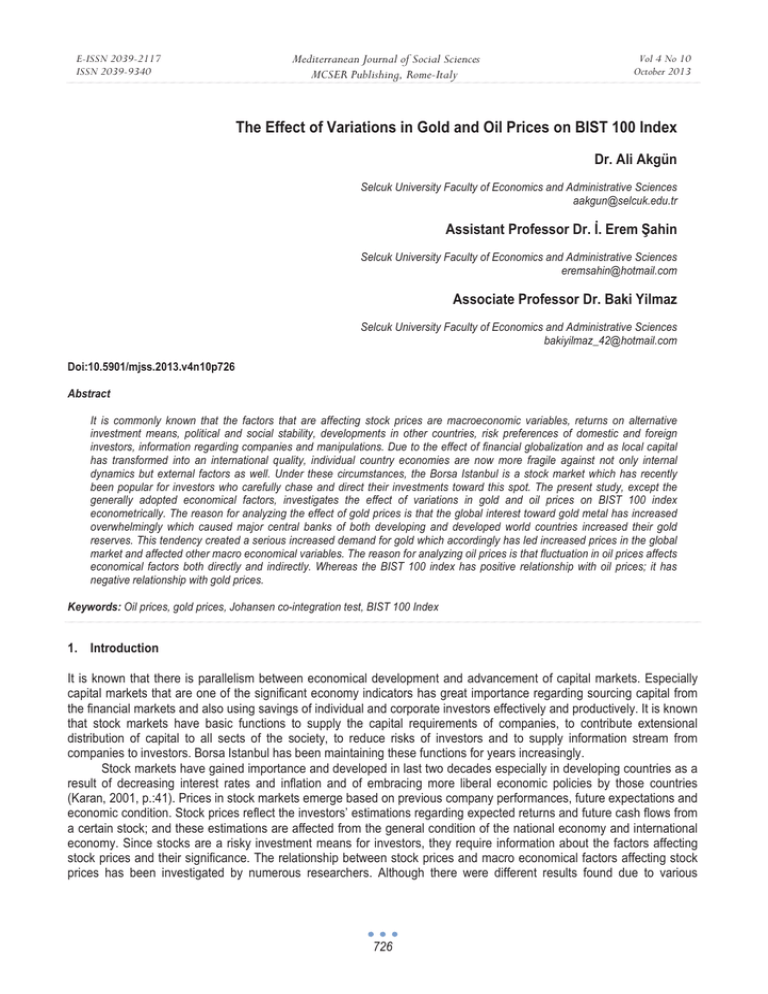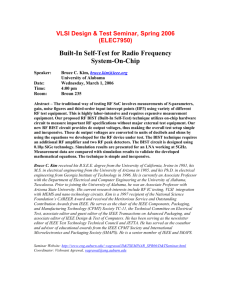The Effect of Variations in Gold and Oil Prices on BIST... Dr. Ali Akgün Mediterranean Journal of Social Sciences MCSER Publishing, Rome-Italy
advertisement

E-ISSN 2039-2117 ISSN 2039-9340 Mediterranean Journal of Social Sciences MCSER Publishing, Rome-Italy Vol 4 No 10 October 2013 The Effect of Variations in Gold and Oil Prices on BIST 100 Index Dr. Ali Akgün Selcuk University Faculty of Economics and Administrative Sciences aakgun@selcuk.edu.tr Assistant Professor Dr. ù. Erem úahin Selcuk University Faculty of Economics and Administrative Sciences eremsahin@hotmail.com Associate Professor Dr. Baki Yilmaz Selcuk University Faculty of Economics and Administrative Sciences bakiyilmaz_42@hotmail.com Doi:10.5901/mjss.2013.v4n10p726 Abstract It is commonly known that the factors that are affecting stock prices are macroeconomic variables, returns on alternative investment means, political and social stability, developments in other countries, risk preferences of domestic and foreign investors, information regarding companies and manipulations. Due to the effect of financial globalization and as local capital has transformed into an international quality, individual country economies are now more fragile against not only internal dynamics but external factors as well. Under these circumstances, the Borsa Istanbul is a stock market which has recently been popular for investors who carefully chase and direct their investments toward this spot. The present study, except the generally adopted economical factors, investigates the effect of variations in gold and oil prices on BIST 100 index econometrically. The reason for analyzing the effect of gold prices is that the global interest toward gold metal has increased overwhelmingly which caused major central banks of both developing and developed world countries increased their gold reserves. This tendency created a serious increased demand for gold which accordingly has led increased prices in the global market and affected other macro economical variables. The reason for analyzing oil prices is that fluctuation in oil prices affects economical factors both directly and indirectly. Whereas the BIST 100 index has positive relationship with oil prices; it has negative relationship with gold prices. Keywords: Oil prices, gold prices, Johansen co-integration test, BIST 100 Index 1. Introduction It is known that there is parallelism between economical development and advancement of capital markets. Especially capital markets that are one of the significant economy indicators has great importance regarding sourcing capital from the financial markets and also using savings of individual and corporate investors effectively and productively. It is known that stock markets have basic functions to supply the capital requirements of companies, to contribute extensional distribution of capital to all sects of the society, to reduce risks of investors and to supply information stream from companies to investors. Borsa Istanbul has been maintaining these functions for years increasingly. Stock markets have gained importance and developed in last two decades especially in developing countries as a result of decreasing interest rates and inflation and of embracing more liberal economic policies by those countries (Karan, 2001, p.:41). Prices in stock markets emerge based on previous company performances, future expectations and economic condition. Stock prices reflect the investors’ estimations regarding expected returns and future cash flows from a certain stock; and these estimations are affected from the general condition of the national economy and international economy. Since stocks are a risky investment means for investors, they require information about the factors affecting stock prices and their significance. The relationship between stock prices and macro economical factors affecting stock prices has been investigated by numerous researchers. Although there were different results found due to various 726 Mediterranean Journal of Social Sciences MCSER Publishing, Rome-Italy E-ISSN 2039-2117 ISSN 2039-9340 Vol 4 No 10 October 2013 periods, places and variables used in researches, existence of these relationships are common findings of these researches. Due to its characteristics as an alternative investment to stocks and as a factor that can affect the stock prices, gold reserves the value of investments. While this characteristic heads off its other specifications, based on recent fluctuations in gold prices during the recent years, it is also recognized as a speculative investment mean as well. When we consider gold as a substitute choice for stocks, an increase in the price of either of them would end up as a price decrease in the other one (Albeni and Demir, 2005:7). In modern economies, oil prices are also considered as an important variable which are affecting capital markets. The general opinion in economies is that capital equity markets would react against the change in oil price (Regnier: 2007). There are interaction between oil prices and capital markets due to direct or indirect economical effects of oil prices. As this interaction changes due to the oil dependency of a relevant country, it arises as a result of reflection of changes in economical parameters which are caused by the oil prices to the capital equity markets. In the financial literature, determination of factors influencing stock prices has been a primary investigation area that constantly continues in terms of investors and portfolio managers. There are limited numbers of studies in which price variations of gold and oil are investigated. The purpose of this study is to determine effect of gold and oil price variations over BIST 100 index. To that end, first the literature search will be summarized and then the econometric method will be included. The analysis findings will eventually revealed and discussed. 2. The Literature Search Studies considering factors that are determinants of stock prices have been primarily focused by researches in the financial literature. Especially, according to expanding globalization and increasing effectiveness of financial liberalization in the latest period, it was observed that the factors affecting the stock prices have been diversified. It was also observed that several factors that once affecting stock prices indirectly before, are now affecting the stock prices directly in our contemporary period. There are limited numbers of studies considering the effects of gold and oil prices which are determined in the international markets on stock markets. However, these factors have been considered together with other factors in previous several studies. Table 1 exhibits several studies regarding effects of gold and oil prices on stock markets and their results. Researcher Country Methodology Period Sadorsky (1999) USA VAR January 1947 April 1996 Faff and Brailsford (1999) Australia VAR 1983 - 1996 Sadorsky (2001) Canada VAR April 1983 - April 1999 El-Sharif et al. (2005) GB Multiple factor analysis 1st January 198930th June 2001 USA ARCH-GARCH 1983-2003 Result It was presented that oil prices changes play significant role in explaining the changes in stock prices; and that there is positive relationship between them. IT was revealed that there is significant and positive relationship between oil prices and oil; gas industry and derivative product industries. A significant and positive relationship was observed between paper and packaging; and significant and negative relationship was found between transportation and banking industries. The increase in oil prices causes increase in stock prices in oil and gas sectors. It was reported that changes in oil prices cause increase on returns on the stock prices in oil and gas industries in Great Britain. In the periods in which gold price increase, returns on stock market decreases. Canada VAR USA VAR 3rd January 2001 and 30th May 2007 January 1986 – December 2005 2nd May 2003 -1st March 2007 January.1957May.2009 In the stock prices of the alternative energy businesses, changes in technology stocks are more effective instead of oil prices. Shocks in oil prices have significant effects on return on stocks in the same month or within one-month period. There is no any expected effects in oil prices or in currency rates. High oil prices increases the possibility to transition from the bull market into the bear market. Tully and Lucey (2007) Henriques and Sadorsky (2008), Park and Ratti (2008) Soytaú and Oran (2008) Chen (2009) Turkey USA Time series 727 Mediterranean Journal of Social Sciences MCSER Publishing, Rome-Italy E-ISSN 2039-2117 ISSN 2039-9340 Nandha and Singh (2011) China May 1994 October 2009 GMM Vol 4 No 10 October 2013 The China stock market is affected by the oil prices in a positive way. Table 1. Studies presenting effects of gold and oil prices on stock prices. 3. Data and Econometric Method In our study that is designated to reveal the relationship between changes in gold and oil prices and the BIST 100 index, logarithmic conversions of monthly data obtained from the R.T. Central Bank Electronic Data Distribution System (EVDS) and from the Energy Information Administration regarding the period of 2000:01-2013:04 were used. Variable BIST GLD BRENT Description Number of Observation Average Standard deviation Minimum Maximum 160 35374.07 20823.54 8392.240 84291.11 160 160 766.4958 62.58656 485.2 32.79806 258.87 18.710 1778.82 132.720 Borsa Istanbul 100 Index Gold Prices Brent Oil Prices Table 2. Descriptive statistics about the applied variables To investigate this relationship, initially stationary of the population was probed through Expanded Dickey Fuller (ADF), Phillips-Perron (PP) and Kwiatkowski-Phillips-Schmidt-Shin (KPSS) tests. Following testing the stationary of population, Johansen Co-integration Test was applied to determine whether they were co-integrated. 4. Findings To obtain significant results in the analysis of time series in terms of econometrics and to overcome spurious regression, stationary tests were conducted for the time series in the first place. In this scope, statistical values were calculated for fixed models and for models with fixed trend through ADF, PP and KPSS unit root tests; and the results were exhibited in Table 3 and Table 4. ADF t-statistics BIST -0.255393 GLD -0.156444 BRENT -1.262040 ǻ BIST -11.0534 ǻ GLD -11.69725 ǻ BRENT -10.31292 PP Critical Values -3.472259 -2.879846 -2.576610 -3.471719 -2.879610 -2.576484 -3.471987 -2.879727 -2.576546 -3.471987 -2.879727 -2.576546 -3.471987 -2.879727 -2.576546 -3.471987 -2.879727 -2.576546 t-statistics -0.317469 -0.162461 -1.289976 -11.02441 -11.68163 -10.31985 Table 3. Unit Root Test Results (Fixed) 728 Critical Values -3.471719 -2.879610 -2.576484 -3.471719 -2.879610 -2.576484 -3.471719 -2.879610 -2.576484 -3.471987 -2.879727 -2.576546 -3.471987 -2.879727 -2.576546 -3.471987 -2.879727 -2.576546 KPSS LM Critical statistics Values 0.7390 1.368411 0.4630 0.3470 0.7390 1.528576 0.4630 0.3470 0.7390 1.391644 0.4630 0.3470 0.7390 0.134149 0.4630 0.3470 0.7390 0.135646 0.4630 0.3470 0.7390 0.040540 0.4630 0.3470 Mediterranean Journal of Social Sciences MCSER Publishing, Rome-Italy E-ISSN 2039-2117 ISSN 2039-9340 Vol 4 No 10 October 2013 For fixed effect models, ADF, PP and KPSS unit root tests show that series of BIST 100 index, gold prices and oil prices were not stationary, but in their first difference they all become stationary. Hence, t-statistic values calculated for the abstract values of the ADF and PP tests were less than the MacKinnon critical values. This finding means that the H0 hypothesis which assumes that series include unit roots is not refused. On the other hand, KPSS test results show that instead of H0 hypothesis which assumes that series were stationary, its alternative hypothesis were true. ADF t-statistics BIST -2.623647 GLD -2.928101 BRENT -3.113423 ǻ BIST -10.99754 ǻ GLD -11.67483 ǻ BRENT -10.27990 PP Critical Values -4.017185 -3.438515 -3.143558 -4.016806 -3.438334 -3.143451 -4.017185 -3.438515 -3.143558 -4.017185 -3.438515 -3.143558 -4.017185 -3.438515 -3.143558 -4.017185 -3.438515 -3.143558 t-statistics -2.782262 -3.026679 -2.925055 -11.01707 -11.65800 -10.28694 Critical Values -4.016806 -3.438334 -3.143451 -4.016806 -3.438334 -3.143451 -4.016806 -3.438334 -3.143451 -4.017185 -3.438515 -3.143558 -4.017185 -3.438515 -3.143558 -4.017185 -3.438515 -3.143558 KPSS LM Critical statistics Values 0.2160 0.126427 0.1460 0.1190 0.2160 0.225126 0.1460 0.1190 0.2160 0.121896 0.1460 0.1190 0.2160 0.096513 0.1460 0.1190 0.2160 0.122410 0.1460 0.1190 0.2160 0.038085 0.1460 0.1190 Table 4. Results of Unit Root Test (Fixed and with Fixed Trend) ADF, PP and KPSS unit root tests calculated for models with fixed trend confirmed the findings above. Thus, it is accepted that series are stationary in their first differencing for fixed-trend models. The fact that series were equally stationary shows that there is probability for BIST 100 index to move parallel along with the gold and oil prices on the long-run. To investigate the existence of this relationship for the long-term, Johansen Co-integration test was applied. To perform this test, the VAR model was estimated by taking optimal delay length (2) determined based on the Schwarz information criterion; and it was tested to see whether there is a structural problem or not. In the second stage, the co-integration test was performed whose results were presented in the Table 5. Sampling: 2000:01-2013:03 Number of observation: 160 Trend estimation: Linear deterministic trend Series: BIST GLD BRENT Delay range: 1 to 2 Trace 0.05 critical Maximum Eigen 0.05 critical Eigen value Prob. statistics value value statistics value None* 0.151849 32.87552 29.79707 0.0214 25.85736 21.13162 At most 0.043567 7.018157 15.49471 0.5755 6.993428 14.26460 1 Normalized co-integration equilibrium BIST= -0.212365GLD + 1.479564BRENT * Represents the refusal of the hypothesis on the 0.05 significance level. ** MacKinnon-Haug-Michelis (1999) p-values. Probability** 0.0100 0.4899 Table 5. Co-integration Test Results Trace and maximum eigen value statistics calculated based on the Johansen co-integration test results show that there is one co-integration vector among series at 5% significance level; in other words, it confirms series act together on the 729 E-ISSN 2039-2117 ISSN 2039-9340 Mediterranean Journal of Social Sciences MCSER Publishing, Rome-Italy Vol 4 No 10 October 2013 long run. From the normalized co-integration equilibrium, one unit increase in oil prices causes 1.479564 unit increase in the BIST 100 index; whereas one unit increase in gold price cause the BIST 100 to decrease by 0.212365 as a negative effect. 5. Result Borsa Istanbul, the capital equity market of Turkey as one of the developing countries, is market that is constantly followed and invested by both local and international investors. Particularly, under the effect of the globalization, as the financial liberalization globally expanding, the Borsa Istanbul has been one of the markets affected from this trend. Due to increasing financial liberalization, the Borsa Istanbul is under the influence of macro economic factors affecting Turkish economy, other stock markets in both developing and developed countries, oil prices, currency rates, gold prices etc. as well. The present study investigates the effects of oil and gold prices on BIST 100 index in terms of econometric dimension. For this purpose, monthly data obtained from the R.T. Central Bank Electronic Data Distribution System (EVDS) and the Energy Information Administration regarding the period of 2000:01-2013:04 were exploited. To determine the relationships between the BIST 100 index and gold the index and the oil prices, at first, stationary characteristic of series was investigated through unit root tests (ADF-PP-KPSS); then through the Johansen Cointegration test, it was checked whether they were co-integrated or not. The Johansen co-integration test results regarding series that are stationary in their first difference, show that the BIST 100 index, oil prices and gold prices present movement together on the long term. These results support the other findings in the literature which exhibit that there is relationship between stock prices and international oil and gold prices. In this sense, it was revealed that investors following stock market index are required to take variations in oil and gold prices into consideration beside the other factors. There is positive relationship between oil prices and the BIST 100 index whereas there is negative relationship between gold prices and the BIST 100 index. In other words, when oil prices increase, the BIST 100 index also increases; and when gold prices increase, the BIST 100 index accordingly decreases. From these relationships, it can be concluded that increase in the oil prices indicates the growth in the global economies; and gold prices affect the BIST 100 index adversely since it constitutes an alternative investment mean. That’s to say, the investor who shorts on the BIST prefers gold as an investment. This clearly exhibits that the characteristic of gold as a safe-harbor for investors is still prevailing. References Albeni, M. and Demir, Y. (2005).͆Makroekonomik Göstergelerin Mali Sektör Hisse Senedi FiyatlarÕna Etkisi (øMKB UygulamalÕ), Mu÷la Üniversitesi SBE Dergisi, Bahar, SayÕ: 14. Chen S.S. (2009). “Do Higher Oil Prices Push the Stock Market into Bear Territory?”, Energy Economics, doi:10.1016/j.eneco. 2009.08.18 El-Sharif I., Dick Brown, Bruce Burton, Bill Nixon ve alex Russell (2005). “Evidence on the Nature and Extent of the Relationship Between Oil Prices and Equity Values in the UK”, Energy Economics, Volume 27, s.819-830 Faff R. W. ve T.J. Brailsford (1999). “Oil Price Risk and Australian Stock Market”, Journal of Energy Finance and Development, Volume 4, s.69-87 Henriquesi I. and P. Sadorsky (2008). “Oil Prices and the Stock Prices of Alternative Energy Companies”, Energy Economics, Volume 30, s.998-1010 Karan, M. B., (2001), YatÕrÕm Analizi ve Portföy Yönetimi, Gazi Kitapevi, Ankara. Nandha, M. and Singh, H. (2011). “Short-run and long-run oil price sensitivity of Chinese stocks”, Corporate Ownership and Control [P], vol 8, issue 2, Virtus Interpress, Sumy Ukraine, pp. 163-169. Park, J. ve R. A. Ratti (2008). “Oil Price Shocks and Stock Markets in the U.S. and 13 European Countries”, Energy Economics, Volume 30, s.2587-2608 Regnier E. (2007). “Oil and Energy Price Volatility”, Energy Economics, Volume 29, s.405-427 Sadorsky P. (1999). “Oil Price Shocks and Stock Market Activity”, Energy Economics, Volume 21, s.449-469 Sadorsky P. (2001): “Risk Factors in Stock Returns of Canadian Oil and Gas Companies”, Energy Economics, Volume 23, s.17-28 Soytaú, U. ve A. Oran (2008). “Dünya Petrol FiyatlarÕndaki De÷iúim øMKB Elektrik Endeksine NasÕl YansÕyor?”, 12. Ulusal Finans Sempozyumu, Enerji YatÕrÕmlarÕnÕn FinansmanÕ ve Enerji Verimli÷i”, 22-25 Ekim, Kayseri, s.216-222 Tully, E. and Lucey, B. M., (2007). “A Power GARCH Examination of the Gold Market”, Research in International Business and Finance, SayÕ: 21. 730






